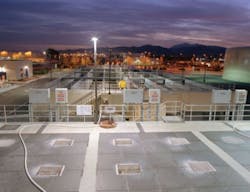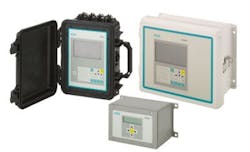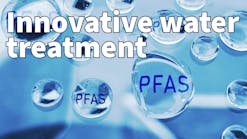Finding the appropriate flow technology in the water and wastewater industry is not easy. Brian Roughan discusses the factors to consider when evaluating selected flow measurement options, including an example of a district metering network operator in Colombia.
Flow measurement is one area that has long been praised as a technology that can potentially save companies thousands of dollars in revenue if it is employed correctly. One major problem, however, is that companies do not necessarily know enough about the available options to make an informed decision about which technology would be the best solution for them. They may have been using one technology for years not knowing or wanting to realise that better, more stable and reliable alternatives have come into play. Regardless of the reason, employing the most applicable flow technology for a specific application or range of applications is absolute key if optimal return on investment is required.
Challenging technology selection
There are numerous options to choose from and they all have their separate strengths and weaknesses. This article will focus on the three main options: electromagnetic, clamp–on ultrasonic and inline ultrasonic flow measurement technologies. All three offer several benefits such as high accuracy, very low maintenance and the capability of handling the water industry’s performance requirements. Although there are similarities between these three technologies, there are also differences, which are important to take into account when evaluating which technology is the most appropriate solution for a given water and wastewater application.
It is important to look at the various similarities and differences to consider when choosing between the electromagnetic and ultrasonic flow measurement technologies. This will enable managers and operators of water processing plants to make an informed decision based on objective facts and criteria.
With inline ultrasonic meters, the flow meter is installed as an integral part of the pipe with the transducers in direct contact with the liquid. Clamp–on ultrasonic transducers, on the other hand, are installed on the outside of the pipe and are therefore, not in contact with the liquid.
Pipe sizes vs. market price
When it comes to the maximum pipe size that electromagnetic and ultrasonic flow meters can be installed on, theoretically there is no limit. In practice, the situation is quite different, which can be attributed to one major factor: market price. For this reason it is difficult to evaluate pipe sizes without also talking about market price.
Over the last few years, the market price of electromagnetic flow meters has gone down considerably. This makes them ideally suitable for water and wastewater installations with relatively small diameter pipes. When pipe sizes go up, however, so does the market price, especially on electromagnetic flow devices above DN 800.
When evaluating where the cut off is between selecting a clamp–on ultrasonic as opposed to an electromagnetic flow meter, from a market price perspective, it is generally considered to be around DN 200–250.
Since a technology selection is likely to be based on a combination of factors and not just price alone, this cut off should be seen as a general rule of thumb only. There are most likely other considerations to an application that might make one technology better suited than the other, even though a more cost–effective alternative is available.
When it comes to inline ultrasonic flow meters in clean water applications (these types of meters do not work well on wastewater), they are particularly cost–effective on larger pipe sizes above DN 800.
Accuracy and custody transfer
Some operators and managers of water and wastewater installations may not be that preoccupied with the accuracy of their equipment. With billing requirements on the rise, however, accuracy should not be underestimated. If a plant is billed for the usage of 20 million m³ of water a year it makes a significant difference whether the flow meter measures with an accuracy of 0.5% or 2%.
With both electromagnetic and ultrasonic flowmeters, high accuracies can be achieved. There are, however, some differences that are worth highlighting. Since electromagnetic and inline ultrasonic meters are built–in solutions that become part of the pipe that carries the measured liquid, both meter types can be calibrated to a guaranteed accuracy. This means that they can be certified to custody transfer specifications and standards. What that does is guarantee the customer a flow meter with a very high accuracy, allowing the meters to be used for billing purposes where such a certificate is required.
Although clamp–on ultrasonic meters are also considered very accurate, they do not become an integrated part of the pipe. For this reason, the exact accuracy depends on various factors: pipe configuration, pipe size, signal strength etc. and therefore, they cannot be calibrated nor used in applications where a custody transfer certificate is required.
Installation methods
When evaluating the various installation methods, the electromagnetic and inline ultrasonic meters can be categorised into one group and clamp–on ultrasonic meters in another.
To install an electromagnetic and an inline ultrasonic flow meter, the process needs to be shut down completely (unless a loop has been installed) since the pipe needs to be cut open. In order to ensure proper connection to the existing pipes, flanges have to be welded into the pipe system.
Although this seems like a time–consuming process, it is worth the while, especially in custody transfer installations where millions of cubic meters of fresh water is distributed to paying customers on a daily basis. Besides being a legal requirement, not having a custody transfer or a calibrated check meter installed could result in a utility plant loosing critical revenue. For installations that do not require custody transfer approvals and calibrated accuracy, but still require high accuracy and repeatability, clamp–on ultrasonic flow meters are another option. Since the transducers are easily mounted on the outside of the pipe, there is no need to cut the pipe. This is an advantage in retrofit, permanent installations where it may be too costly and time–consuming to cut open the pipe to install an inline meter.
Consider a drinking water installation where opening the pipe carries the risk of polluting or contaminating the water if dirt or sand gets into the pipe system. In such cases the clamp–on ultrasonic flow meter is a perfect solution. This also goes for water installations in office buildings and public water supply distribution pipes.
Approvals
Basically, there are no limitations to the number of approvals to be applied to the electromagnetic and inline ultrasonic flowmeters; it all depends on the markets that the manufacturer wishes to enter. When it comes to clamp–on ultrasonic meters, however, the transducers are not in contact with the media, alleviating the necessity for hygienic and drinking water approvals.
Communication
In order for a flow meter to deliver data to any external device it needs to be equipped with a communication interface. Today, there are several types of open as well as closed communication protocols that provide various levels of functionality and security. Most of the modern electronic flow meters have various communication options available that enable integration not only to a laptop, for instance, but also to process control systems that run, monitor and control entire water distribution plants.
Repeatability
Even if the repeatability of a flow meter has little to do with the technology but rather depends on the manufacturer’s ability to produce a meter with a solid performance, it is worth mentioning. The reason being that some believe that good repeatability is a measure of good accuracy. This is not true.
To understand the differences between accuracy and repeatability, imagine two archers shooting at an archery target. One archer hits the bull’s–eye consistently, which makes him both accurate and consistent (repeatable). The other archer hits the target but misses the bull’s–eye every time, making him consistent but not accurate. The lesson to be learned is that good repeatability does not guarantee accuracy. This is important to keep in mind when assessing which flow meter to purchase.
Evaluating your needs
Electromagnetic and ultrasonic flow meters of today are vastly different compared to 10 years ago. They require little or no maintenance, they are so accurate that most of them can be used for custody transfer applications (if certified) and they are extremely reliable. Although the initial cost, including flow meter, spare parts, crew training etc. may be higher when compared to an existing solution, stepping out of the box can in fact pay off long term or, as the case study from Colombia shows, in the short–term as well.
Before making such a commitment, however, water and wastewater plant operators need to properly evaluate their needs and make an informed decision as to what they can get. And sometimes this means coming to the conclusion that there are numerous solutions to choose from that are equally suitable for solving the challenge at hand.
Author’s note: Brian Roughan is business development manager, water business at Siemens AG. Further information can be found at: www.siemens.com/flow
Case Study– Colombia
A private district metering network operator in Colombia, South America, had several considerations to take into account when choosing a new flow meter to upgrade its network. The district metering network was located in the Colombian Cost region. When it was criticised for a much needed upgrade to satisfy the growing need for a reliable source of clean and safe drinking water, the focus was on finding a flow meter that lived up to the requirements of accurate measurement and low cost of ownership. After careful consideration, an electromagnetic flow meter was chosen. Some of the aspects that influenced this choice included:
– The pipe sizes ranged from DN 80 to DN 150, making it a great fit for the electromagnetic flow meter from a cost–benefit perspective
– Although the choice of the electromagnetic flow technology prolonged the installation time, the possibility for factory calibration and subsequent on–site recalibration made it worth the investment. The operator would be certain of the accuracy for the particular application, which was a prerequisite for achieving the efficiency improvements resulting from the upgrade
– Modern electromagnetic flow meters come with various communication options that allow for adaption to the specific application. In this case, the chosen flow meter supported wireless data transmission, which fit in with the strategy to future–proof the system for coming upgrades
– Extra features that were part of the chosen flow meter included use of the data logger’s storage capacity to define various consumption situations based on actual weather conditions and consumption profiles, and leak detection capabilities that allowed easy recognition of scenarios that could indicate possible leaks
Before the replacement of the existing flow meters it was estimated that the network efficiency was around 30–35%, meaning that more than half of the drinking water was wasted. After only two years of operation, however, the efficiency of the Colombian water distribution network has risen to 90–95%, making the authorities gain payback much quicker than originally anticipated.
More Water & WasteWater International Current Issue Articles
More Water & WasteWater International Archives Issue Articles





